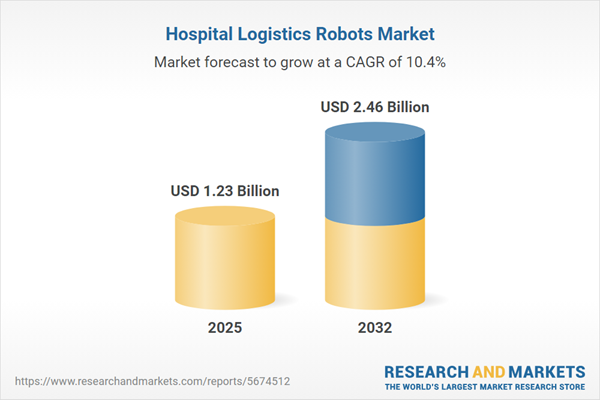Speak directly to the analyst to clarify any post sales queries you may have.
Hospital logistics robots are driving a new standard for hospital efficiency and operational resilience. As healthcare organizations face pressure to optimize staffing, resource management, and scalability, automation solutions offer leaders a direct pathway to stronger service delivery and consistent quality care.
Market Snapshot: Growth Outlook for the Hospital Logistics Robots Market
The hospital logistics robots market is advancing steadily as digital transformation takes hold across healthcare operations. Market analysis projects expansion from USD 1.11 billion in 2024 to USD 1.23 billion by 2025, ultimately reaching USD 2.46 billion by 2032. This trend reflects a compound annual growth rate (CAGR) of 10.42% and is supported by widespread adoption efforts centered on automation, infrastructure enhancement, and risk management improvement.
Leaders nationwide are embedding logistics robotics to strengthen compliance, mitigate errors, and eliminate procedural inefficiencies while supporting broader organizational goals.Scope & Segmentation of the Hospital Logistics Robots Market
- Robot Types: Automated Guided Vehicles (AGVs) and Autonomous Mobile Robots (AMRs) facilitate rapid, automated movement of critical items such as medical supplies, pharmaceuticals, and laboratory specimens. Utilization reduces manual labor, enhancing capacity for frontline care delivery.
- Applications: Typical deployments include material handling, medication distribution, specimen carriage, meal transport, and waste management. These use cases help establish consistent workflows, standardize operational safety, and minimize workflow errors for medical teams.
- End Users: Hospitals, ambulatory surgery centers, diagnostic labs, and research institutions leverage logistics robots to drive resource utilization, maintain high service standards, and manage operations across multiple sites.
- Payload Capacities: Available systems support both lightweight and high-capacity tasks, enabling seamless scalability from single facilities to complex healthcare networks based on specific workload and infrastructure needs.
- Navigation Technologies: Technologies such as inertial sensors, laser vision, LiDAR, and magnetic tape offer reliable navigation in dynamic hospital environments, accommodating ongoing changes in infrastructure and workflow requirements.
- Regions Covered: Adoption is active in the Americas, EMEA, and Asia-Pacific, impacted by unique regional regulatory frameworks, healthcare infrastructure investments, and differing priorities around patient care outcomes.
- Key Companies Profiled: Leading providers including Corvus Robotics Inc., DF Automation and Robotics Sdn Bhd, Diligent Robotics Inc., IAM Robotics, John Bean Technologies Corp., Kollmorgen Corp., MIDEA Group Co., Ltd., Mobile Industrial Robots AS, OMRON Corp., and PAL Robotics, address the broad spectrum of logistics needs in the healthcare sector.
Key Takeaways: Strategic Insights for Senior Decision-Makers
- Automated robotic platforms relieve clinical teams of repetitive material movement and inventory duties, redirecting focus to patient-centered care and complex clinical decisions.
- Seamless integration with electronic health records and analytics platforms fosters data-driven operational management and standardizes decision-support processes.
- Cross-functional cooperation between IT and clinical stakeholders underpins effective logistics robot adoption, aligning deployments with compliance mandates and institutional priorities.
- Investment in modular, adaptable robotics solutions empowers organizations to meet changing care delivery models, enabling both capital efficiency and operational flexibility.
- Standardized interfaces and clear service-level agreements support smoother change management, improving staff engagement and adoption rates during technology rollouts.
Tariff Impact: Supply Chain and Sourcing Strategies
Forthcoming tariff changes in the U.S. have prompted healthcare operators to re-evaluate procurement models for hospital logistics robots. Many are considering regional or domestic manufacturing partnerships to gain better cost control, reduce turnaround times, and navigate regulatory adaptations with greater ease.
Methodology & Data Sources
This analysis is based on structured executive interviews, sector-specific regulatory reviews, and direct observation of active robotics deployments in hospital settings. Both qualitative perspectives and quantitative trends inform the recommendations for procurement, integration, and process optimization.
Why This Hospital Logistics Robots Market Report Matters
- Provides benchmarking insights to help executives align automation investments with operational and staffing objectives.
- Clarifies the roles of leading vendors and the structure of the market, enabling more strategic and efficient supplier evaluations.
- Delivers support for compliance planning and robust integration, guiding organizations to minimize workflow obstacles during digital transformation efforts.
Conclusion
Strategic use of hospital logistics robots reinforces operational agility and sets the foundation for high-quality healthcare delivery. Investing in scalable automation positions healthcare organizations to meet current performance targets and prepares teams for future demands.
Additional Product Information:
- Purchase of this report includes 1 year online access with quarterly updates.
- This report can be updated on request. Please contact our Customer Experience team using the Ask a Question widget on our website.
Table of Contents
3. Executive Summary
4. Market Overview
7. Cumulative Impact of Artificial Intelligence 2025
Companies Mentioned
The companies profiled in this Hospital Logistics Robots market report include:- Corvus Robotics Inc.
- DF Automation and Robotics Sdn Bhd
- Diligent Robotics Inc.
- IAM Robotics
- John Bean Technologies Corp.
- Kollmorgen Corp.
- MIDEA Group Co., Ltd.
- Mobile Industrial Robots AS
- OMRON Corp.
- PAL Robotics
Table Information
| Report Attribute | Details |
|---|---|
| No. of Pages | 193 |
| Published | November 2025 |
| Forecast Period | 2025 - 2032 |
| Estimated Market Value ( USD | $ 1.23 Billion |
| Forecasted Market Value ( USD | $ 2.46 Billion |
| Compound Annual Growth Rate | 10.4% |
| Regions Covered | Global |
| No. of Companies Mentioned | 11 |









